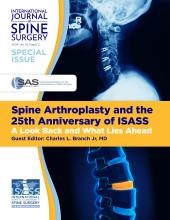ABSTRACT
Background Lateral lumbar interbody fusion (LLIF) affords a wide operative corridor to allow for a large interbody cage implantation for segmental reconstruction. There is a paucity of data describing segmental lordosis (SL) achieved with lordotic implants of varying angles. Here we compare changes in SL and lumbar lordosis (LL) after implantation of 6°, 10°, and 12° cages.
Methods We retrospectively reviewed LLIF cases over a 5.5-year period. We derived SL and LL using the standard cobb angle measurement from a standing lateral radiograph. We analyzed mean changes in SL and LL over time using the linear mixed effect model to estimate these longitudinal changes.
Results The most frequently treated level was L3–4, followed by L4–5. Significant increases in mean SL were found at each follow-up time point for all the cohorts. In an intercohort comparison, the mean changes in SL at immediate postoperative and last follow-up were significantly greater in the 10° cohort than 6° ([7.4° versus 3.1°, P = .004], [6.1° versus 2.3°, P = .025] respectively). The 12° cohort had higher mean change in SL at last follow-up than the 6° cohort (5.9° versus 2.3°, P = .022). There was no difference in mean change in SL between the 10° and 12° cohorts. No difference in overall mean LL over time was found. In terms of mean change in LL, no difference was observed except at immediate and 6-month postoperative in the 10° cohort ([9.6°, P = .001], [8.5, P = .003] respectively). By comparing mean change in LL, no difference existed except between the 10° and 6° immediately after surgery (9.6° versus 0.2°, P = .006).
Conclusions LLIF cages significantly improve SL at the index level. However, this increase in SL is greater for 10° and 12° cages than the standard 6° cage. Use of 10° cages also resulted in overall improved LL than 6° cages.
Level of Evidence 3.
Clinical Relevance Lateral lumbar interbody fusion.
- lateral lumbar interbody fusion
- LLIF
- segmental lordosis
- SL
- lumbar lordosis
- LL
- standard lordotic cages
- transpsoas
- cage dimension
- cage angulation
- 6° cage
- 10°cage
- 12° cage
Footnotes
Disclosures and COI: Dr. Fontes is a consultant for Globus Medical. Dr. Fessler is a consultant for DePuy Synthes, receives royalties from DePuy Synthes, and has co-ownership in In Queue Innovations. Dr. O'Toole is a consultant for Globus Medical, receives royalties from Globus Medical, receives royalties from RTI Surgical, and has stock ownership in TheraCell, Inc. The other authors received no funding for this study and report no conflicts of interest.
- This manuscript is generously published free of charge by ISASS, the International Society for the Advancement of Spine Surgery. Copyright © 2021 ISASS







